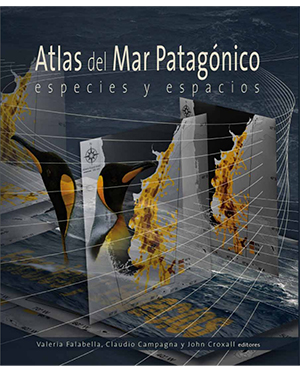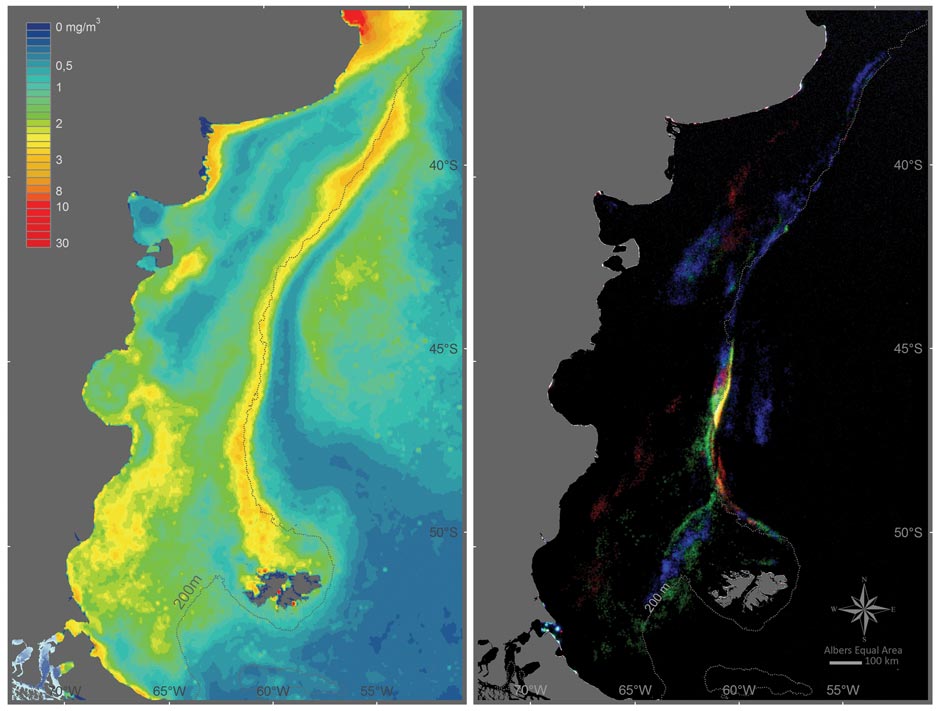SACC: An international consortium for the study of ocean related global and climate changes in South America (CRN 2076)

1) Satellite derived sea surface chlorophyll distribution in the Southwest South Atlantic in January (values range from 0 mg∕m3 (blue) to 20 mg∕m3 (red).
2) Deployment of a Conductivity-Temperature-Depth profiler in the Western South Atlantic.
3) Sea surface height anomaly (left) and sea surface salinity (right) from a regional high-resolution ocean model.
Project information
Servicio de Hidrografía Naval (Argentina)
This research continued in SGP-CRA 2076, with the same title
Executive summary
Oceans play a huge role in the global climate system; they sequester greenhouse gases, move heat from the equator to polar regions and control the global hydrology. Oceans, especially their continental margins, have soaked up half of the man-made CO2 emissions since the mid 1800s. Oceanic phytoplankton produces half of the Earth’s chlorophyll, and half of this is found on continental shelves which occupy only 9% of the ocean area. Researchers in this project are studying exchange processes between the deep ocean and the Patagonian shelf, and how these vary in time. Direct observation, historical data and modifications to earth system models all contribute to understanding ocean circulations and ocean biota.
Goals
Identify the physics, and the currents and tides that control physical and biogeochemical exchanges (species, nutrients, CO2, sediments) between the deep ocean and the continental shelf, and their variability
Determine the influence of currents and inflows on the production and biodiversity of the marine environment
Improve understanding of the dynamic processes controlling upwelling and cross-shelf exchanges for the development of better global carbon models
Results
The Patagonia shelf, which covers 4% of the global continental margins, absorbs about 17 Tg C yr-1 (million metric tons of carbon per year).
The important fishery on the shelf break, with about two million tons of fish and squid landed every year (3% of global production) shows signs of overfishing, indicated by growing jellyfish populations. This is important to monitor and manage since overfishing could affect plankton and alter the capture CO2 through photosynthesis.
The project contributes to developing state-of-the-art ocean models that more realistically represent the circulation and upwelling mechanisms which sustain the productivity of the shelf break.
Freshwater input from the Rio de la Plata and Patos Lagoon is important for ecosystem production and diversity in the Southwest Atlantic.
CRN2076 and various Argentinean institutions maintain BioMare, an integrated fishery and oceanographic information system to support fishery policies. BioMare developers expect to expand the system beyond Argentina.
Outreach
In December 2011, the IAI hosted a side-event during COP-17 in Durban, South Africa on “Blue carbon research: biological, physical, chemical processes in oceanic carbon sinks and sources”. Based on IAI research in the South Atlantic, we discussed how ocean circulation affects blue carbon: the links between biological carbon sequestration, chemical absorption, physical transport and possible re-release to the atmosphere; and what this implies for carbon management options. Further information on the event can be found here
Project investigators
Alberto Piola – apiola@hidro.gov.ar
Servicio de Hidrografía Naval (Argentina)
Edmo J.D. Campos (IO, USP, Brasil)
Carlos M. Martinez (UR, Uruguay)
Ricardo P. Matano (Oregon State University, EE.UU.)
Hermes W. Mianzan (INIDEP, Argentina)
Osmar O. Möller Jr. (Universidade Federal do Rio Grande, Brasil)
José H. Muelbert (Universidade Federal do Rio Grande, Brasil)
Patrizia Raggi Abdallah (Universidade Federal do Rio Grande, Brasil)
Oscar Pizarro (Universidad de Concepción, Chile)
Links to other IAI projects
Research in this project is complemented by the Human Dimensions component 2076-HD on artisinal fisheries in the Patos Lagoon
Project website: http://www.sacc.org.uy
List of publications: http://sacc.coas.oregonstate.edu/~sacc/documents.php?ano=2014&cat=Scientific_Articles
Publications Updated 3/2010
Students
Barbara Franco, PHD, Universidad de Buenos Aires, Argentina.
Carla Derisio, Post PHD, Instituto Nacional de Investigacion y Desarrollo Pesquero, Argentina.
Chris van Assen, Post PHD, Argentina.
Daniel Valla, Undergraduate, Universidad de Buenos Aires, Argentina.
David Oks, Undergraduate, Universidad de Buenos Aires, Argentina.
Dernis Mediavilla, PHD, Universidad de Concepción, Argentina.
Eugenia Azcuaga, Undergraduate, Argentina.
José Luiz Lima de Azevedo, PHD, Brazil.
Juan Carlos Ugaz Codina, PHD, Universidade Federal do Parana, Brazil.
Laura A. Ruiz Etcheverry, PHD, Centro de Investigaciones del Mar y de la Atmósfera, UBA, Argentina.
Magdalena Carranza, Undergraduate, Argentina.
Mara Braverman, PHD, Argentina.
Marina Marrari, Post PHD, INIDEP, Argentina.
Miriam Vergani, PHD, INIDEP, Argentina.
Monique Franza, Master, Brazil.
Paulo Costa Campos, Master, Universidade Federal do Rio Grande, Brazil.
Priscila Orozco, Undergraduate, Universidade Federal do Rio Grande, Brazil.
Roxana Rodriguez, Undergraduate, Universidad de Concepción, Chile.
Sergio A. Rosales, Master, Universidad de Valparaiso, Chile.
Susana Giglio, Master, Universidad de Valparaiso, Chile.
Uriel Zajaczkovski, Undergraduate, Universidad de Buenos Aires, Argentina.


